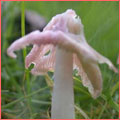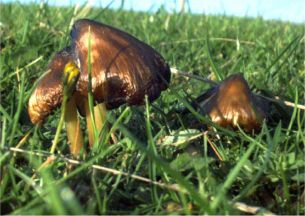|
Waxcaps need short turf (i.e. regularly mown or grazed),
no fertiliser or lime input and no disturbance, e.g. ploughing
or reseeding.
Due to the continued loss of unimproved grassland habitats,
waxcap grasslands generally and certain waxcap species in
particular have become more restricted in their distribution.
Of particular concern are two species, H.
spadicea (date-coloured waxcap) and H.
calyptriformis (pink meadow waxcap or ballerina).
It is very pleasing to see that in recent years, the statutory
bodies responsible for upkeep of the British countryside have
devised effective action plans for waxcap fungi. The
involvement of Plantlife
as a campaigning organisation is also very welcome.
|
 |
Biodiversity Action Plans (BAPs):
Three types of Action Plans have been developed which set
priorities for nationally important and locally important
habitats and wildlife - The three action plans are; Species
Action Plans (SAPs), Habitat Action Plans (HAPs)
and Local Biodiversity Action Plans (BAPs).
For more information visit www.ukbap.org.uk
BAPs have been developed for two waxcap species; H. spadicea
(date-coloured waxcap) and H. calyptriformis (pink
meadow waxcap or ballerina), as well as for the earth tongue
Microglossum olivaceum which also inhabits oligotrophic
grasslands (Fleming, 2001).
To conserve Churchyard Fungi : :
1) Keep areas good for fungi well mown.
2) Remove grass clippings if possible
3) Reduce mowing to favour flowers in areas less important
for fungi.
4) Do not use any lawn feeds, fertilizers, moss killers etc.
Do not reseed.
|
 |
To conserve Lawn or other Grassland
Fungi : :
1) Keep well grazed or mown.
2) Use no fertilisers.
3) Do not reseed.
4) Keep well-drained.
5) Avoid deep shade.
|

